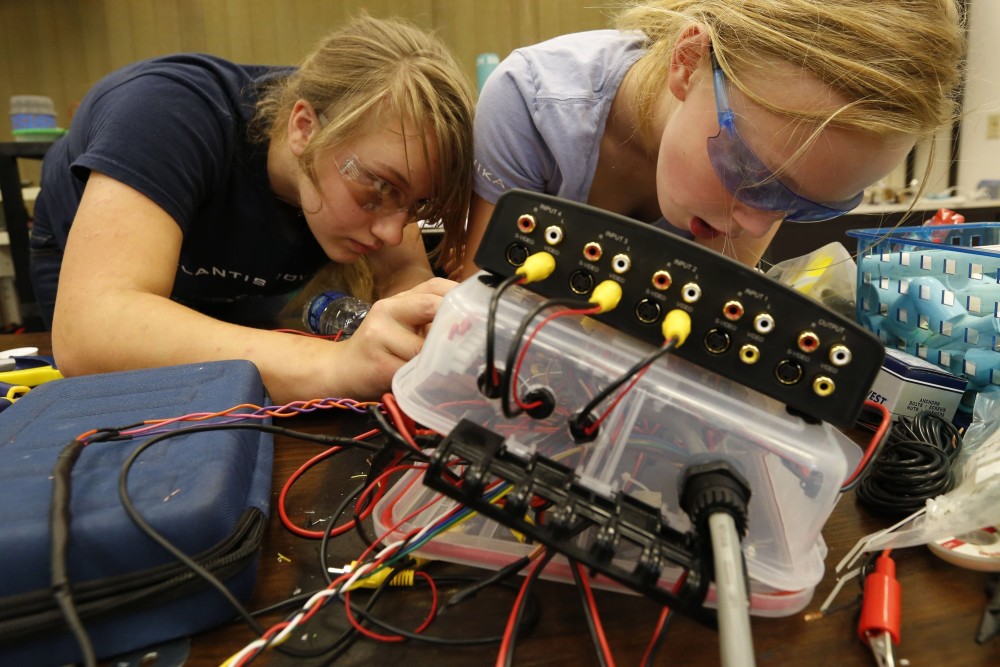By Jacqueline Lee
Palo Alto Daily News, Calif.
WWR Article Summary (tl;dr) Students from the Castilleja School in Palo Alto are inspiring students from China through and exchange program which focuses on empowering women in tech. This is the fourth year a Shanghai school has sent students to Castilleja to learn more about how the school inspires interest in science and technology. The school, which relies on strong mentorship among peers as well as from teachers, alumni and working engineers, has been enormously successful in getting girls involved in robotics.
Palo Alto Daily News, Calif.
Helen Jiang and five other students from Shanghai watched as the Castilleja School robotics team hurriedly wheeled their robot to the pit, eager to fix a wheel base that popped out of alignment in the last bout.
Moments earlier, drivers from the all-girls “Gatorbotics” team navigated their robot through obstacles in a medieval-themed arena to lob balls into towers.
The match on Saturday was part of a high school robotics competition in San Jose. Castilleja ultimately ranked in the middle of 60-odd teams in the international competition.
But to Jiang, the event was less about winning than just having a chance to compete.
“I want our school to start some classes or clubs about robotics, so girls at my school also have a chance at this,” Jiang said.
Jiang said her primary school in China had programs where students could build basic robots, but acknowledged that the funding and materials needed for higher levels of competition is hard to come by in China.
Yang Zhijun, a physics teacher from Shanghai No. 3 Girls School accompanying the group of six students visiting Castilleja this week, said the Shanghai school wants to establish a program in the next two years. Each year, educators and students get a better sense of what skills and resources are needed to establish a robotics program, she said.
The Shanghai school also hopes to establish relationships with Silicon Valley giants such as Apple to make the program possible, Yang said.
After this trip, Yang would like to start a club at the school with physics and computer science teachers to foster interest in robotics. The idea is that the next group of students the school sends to Palo Alto would be members of a club representing a mix of grade levels from the school with about 800 students.
In the past, students earning a spot in the exchange program were upperclassmen who graduated without passing on to younger students much of what they learned in Palo Alto.
This is the fourth year the Shanghai school has sent students in the exchange program with Castilleja to learn more about how the school inspires interest in science and technology as well as innovation in other classes, such as literature.
Head of School Nanci Kauffman invited the Shanghai school to send a delegation after her 2012 visit to China to speak about STEM education showed her that the school was struggling to engage girls in robotics. Castilleja first sent students on education trips to China in 2010.
Yang said the Shanghai school wants to emulate Castilleja’s success in getting girls involved in robotics, which relies on strong mentorship among peers as well as from teachers, alumni and working engineers.
Days after the competition, Castilleja sophomores Arushi Gupta and Rashi Bose were in the campus’ Bourn Lab showing the Shanghai students how to program autonomous robots.
The small robots, named Bashful and Grumpy after dwarfs in “Snow White,” were built by Castilleja students and used in the middle school robotics competitions, where the robots are preprogrammed.
With the help of a Chinese-English dictionary, Jiang asked Gupta how to program the robot so it could make a movement similar to a forklift or bulldozer.
Gupta, a mentor for the Castilleja middle school robotics girls, said the school promotes an environment where “girls get involved in whatever they’re interested in.”
The middle school students involved in robotics are passionate about learning skills, Gupta said.
“I love seeing how excited and invested they are in programming,” she said. “I have students who take boards home to work on.”
Castilleja girls benefit from having “plenty of role models,” including teachers and industry professionals in Silicon Valley, Gupta said.
One such mentor is Edina Lee, a Castilleja graduate studying engineering at the University of Michigan.
Lee wasn’t part of the robotics team at Castilleja, but she finds her role as a “Gatorbotics” coach meaningful and rewarding.
Gupta said other students might not have the same access to mentors, and promoting girls in STEM fields elsewhere is an issue.
“Casti’s somewhat of a bubble,” she said. “It doesn’t seem like as much of a problem when we’re surrounded by role models.”
Gupta, whose parents have computer science backgrounds, attended an international school in India for middle school, where she competed in an international robotics competition in eighth grade. She was the only girl on the team, but her teammates didn’t make it an issue, she said.
Still, she notices the “imbalance of guys and girls” at competitions today.
There were at least four girls teams at the competition, including “Space Cookies Robotics” with members of Girl Scout Troop 62868.
Some of the teams were co-ed, including Paly Robotics Team 8 and the Gunn (High School) Robotics Team. Team 8 actively recruits girls, said team member Shota Yamamoto. The sophomore said one change that has helped is having women make up half of the leadership team.














































































































































































































































































































































































